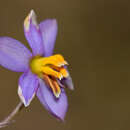en
names in breadcrumbs


Cyanella hyacinthoides ("lady's hand" or "Raaptoluintjie") is a species of cormous annual or perennial herb native to the western parts of South Africa.
It has a basal rosette, with slender, lanceolate, crisped (wavy-margins) leaves.
The mauve, pink, purple or blue (rarely white) flowers are mildly scented, and appear on a spreading inflorescence in Spring (August to November in the southern hemisphere). The plant can be up to 40 centimetres high.[2][3]
It is native to the Cape region of South Africa, especially the renosterveld, where it usually grows in loamy soil in clay and granite slopes. Its range extends as far north as the Namaqualand, and southwards into the Overberg region of the southern Cape, as far as the town of Riversdale.
It is also reportedly naturalised in Western Australia.[4]
The bulb is edible once cooked, and is said to serve as an onion substitute.[5]
It tolerates drought but is vulnerable to frost.
Cyanella hyacinthoides ("lady's hand" or "Raaptoluintjie") is a species of cormous annual or perennial herb native to the western parts of South Africa.
Cyanella hyacinthoides é uma espécie nativa da África do Sul.
A planta apresenta um caule muito ramificado com até 40 centímetros de altura, com flores nas cores branca, rosa, roxo ou azul. A erva possui cormo. [2][3]
O bulbo é comestível depois de cozido, e pode servir como um substituto cebola.[4]
A planta tolera a seca, mas é vulnerável à geada.
É nativa da região do Cabo da África do Sul, onde cresce nas encostas tendo como substrato argila e granito. Ele também é encontrada na Austrália Ocidental.[5]
Cyanella hyacinthoides é uma espécie nativa da África do Sul.
Cyanella hyacinthoides là một loài thực vật có hoa trong họ Tecophilaeaceae. Loài này được Royen ex L. mô tả khoa học đầu tiên năm 1754.[2]
Cyanella hyacinthoides là một loài thực vật có hoa trong họ Tecophilaeaceae. Loài này được Royen ex L. mô tả khoa học đầu tiên năm 1754.